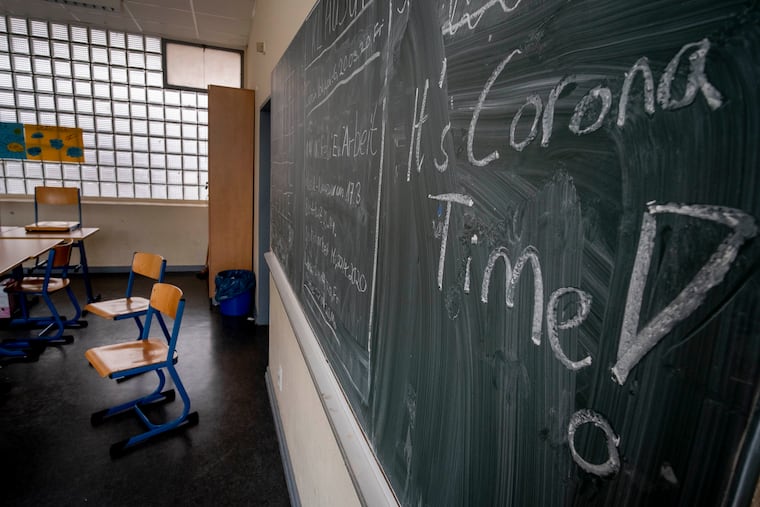Europeans are sending kids back to school. Why can’t we? | Trudy Rubin
In contrast to the USA, European countries have crushed the curve and tamped down infections which makes it safer to reopen work and schools.

In Denmark, Germany, and Austria, kids began returning to classrooms in April and early May, and there haven’t yet been spikes of new cases. Schools reopened in Norway, but the spread of infection in the country keeps trending downward. Italian kids will go back to classes in September.
The reason European countries are reopening schools and parents are willing to send their kids is because most of those countries had flattened the curve on COVID-19 by May or June (our East Asian allies did so even earlier).
That is true even of countries like Italy and Spain that botched their virus response at the outset. Yes, there have been some new spikes as young people surge into bars but nothing that isn’t containable.
Americans don’t have to numb themselves to at least 70,000 more dead by fall and accept tens of thousands of new cases a day as the new normal — as the White House clearly hopes they will. The European experience proves that such an option is obscene.
» READ MORE: Europe wants to ban U.S. travelers because we can't control COVID-19 I Trudy Rubin
I asked Lucia Annunziata, one of Italy’s leading journalists and talk-show hosts, how her country emerged from an awful outbreak and heavy death toll to the current reopening of businesses, restaurants, cinemas, and low caseload.
As of July 8, the seven-day average of new cases in Italy was 198, while in the United States over that period, the average was 52,636. (Italy’s population is roughly one-fifth that of the United States.) And the disparity is not due to U.S. testing, as Italy is testing far more intensively than the United States.
Annunziata told me: After a slow start, when the virus spread ferociously in northern Italy, the country went through a fairly serious lockdown, with schools closed, with each region closing its borders to the others. When natives of southern Italy jammed trains to return home from the north, they were met at train stops by carabinieri who asked them to go be tested.
Gradually, a strong health system in the north brought the caseload and death rate down. But, as elderly people died by the thousands, Italians took the disease very seriously, especially masking and testing.
“A virus here is seen as a virus, not a political instrument,” Annunziata told me by phone from Capri, where she was finally getting a break from work as the virus threat diminished. “When Matteo Salvini [a right-wing populist touted as a future prime minister] tried not to mask in public, people made fun of him and said ‘put it on,’ even his supporters.”
Now, she says, the key to keeping the rate down is “check, chase, and catch,” meaning identifying any spike as soon as it appears, tracing all contacts, and isolating the sick. “People ask you everywhere you visit to sign in with your phone, for example in restaurants, entertainment, or ferries,” she explained, “so if anyone becomes infected they can track their contacts and see where the cluster is.”
That kind of testing and contact tracing regime requires coordination from top governmental levels down to state and localities. This has yet to emerge in any systematic way in the United States. Instead, President Trump confuses the sheer numbers of U.S. tests with an effective testing strategy that would keep infections down by tracing outbreaks and limiting their spread. The lack of such a U.S. strategy, at the top or at state levels, makes it almost impossible to contain the virus.
I heard a similar story about Germany’s reopening from Anna Sauerbrey, deputy editor in chief of the Berlin daily Der Tagesspiegel. Germany is one of Europe’s premier pandemic success stories, with roughly 9,000 deaths in a population of 83 million.
Businesses (which were never fully locked down) are open, while most people still mask in markets, shops, and public transportation. Schools have partly reopened and are mostly operating in shifts in order to allow more space for social distancing. Germany’s federal states are waiting to see whether infection rates rise over summer break before making final plans for reopening.
There were three key elements to Germany’s success, Sauerbrey told me: the country’s early reaction to the virus, its strong health system, and an immediate resort to intensive and widely available testing – along with contact tracing. “Once it spreads as in the United States it is very hard to control,” she correctly noted.
» READ MORE: Trump joins 'ostrich alliance' that puts politics above science I Trudy Rubin
But equally critical for virus control and reopening society was the leadership of Chancellor Angela Merkel, she said. “Merkel brought together the heads of the 16 federal states [from different political parties], who have the power to shut schools and public transport, and got them to agree on a few rules. So it was easy for German citizens to understand how to behave, because there were the same rules everywhere.”
That national-state political unity has fractured, Sauerbrey says, as elected officials compete for reopening, but “it makes less difference when the country is already safe.”
In other words, once Germany, Italy, and other European states have crushed the curve, they are in position to reopen and cope with new spikes by testing, tracing, and isolating. We all know what needs to be done.
Tragically, we can’t imitate what our European allies have done so long as we have a president who pretends the disease will disappear by itself.